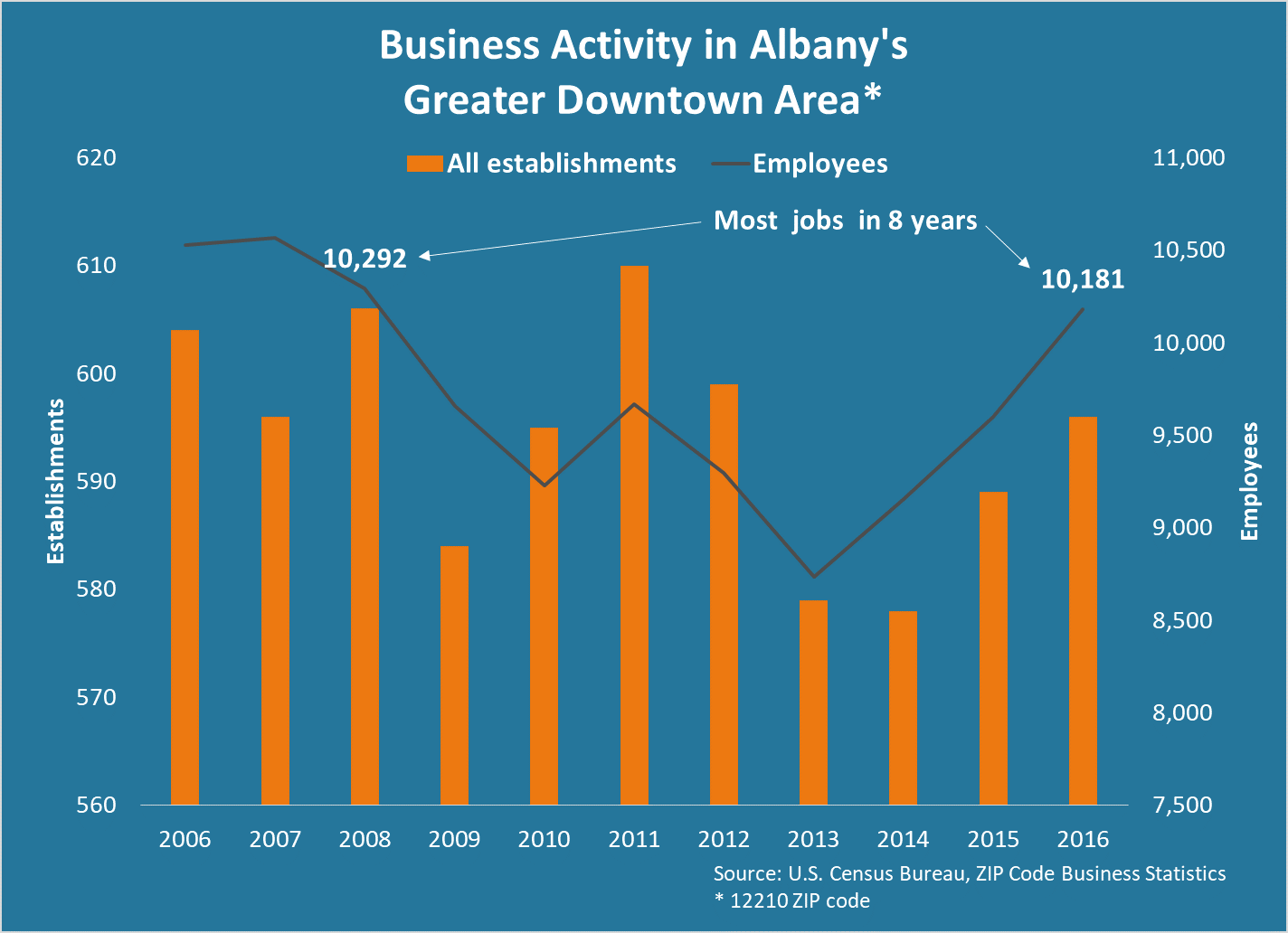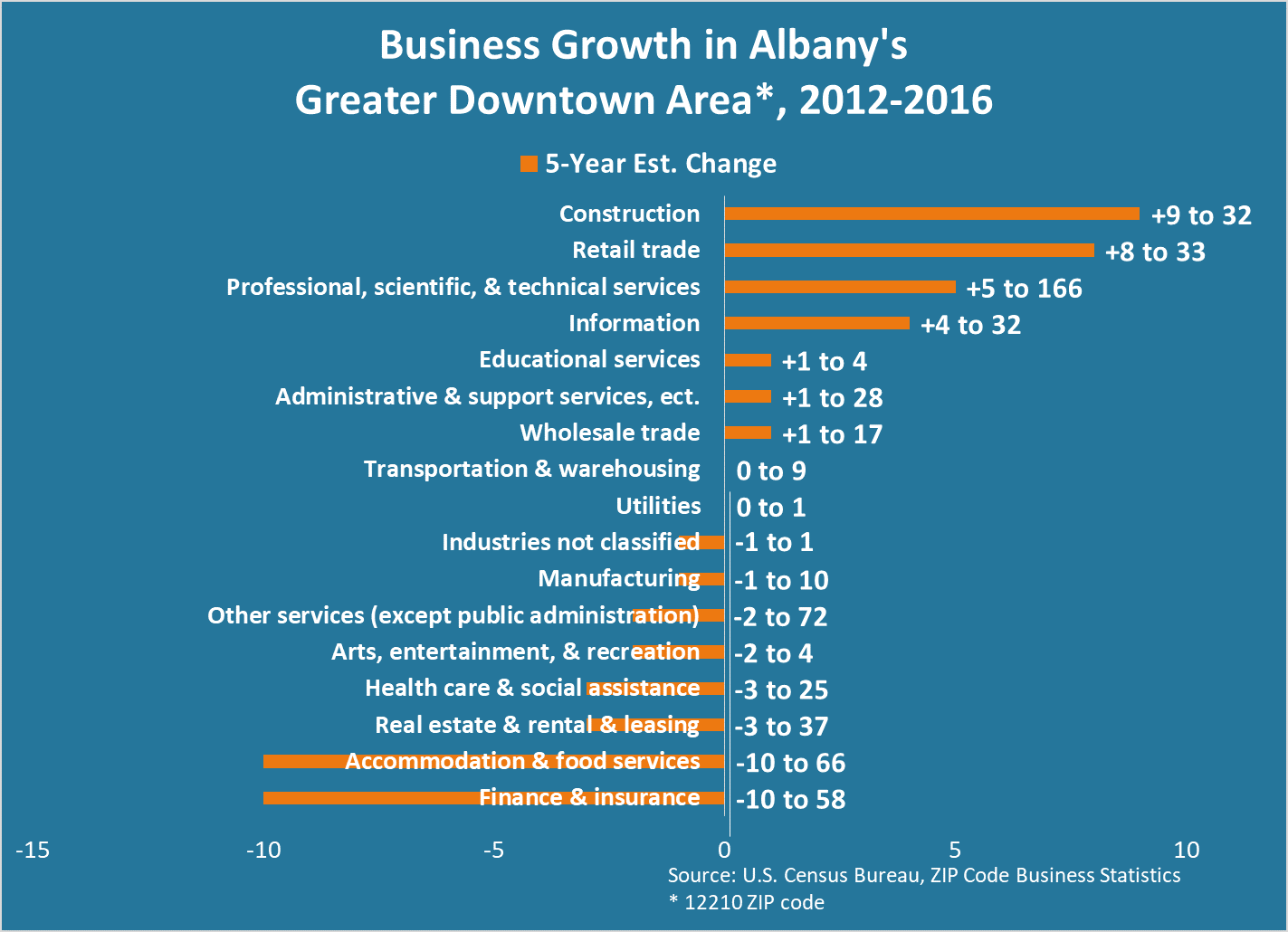Employment in Downtown Albany at 8-Year High
Business activity in Albany’s greater downtown area continues to rebound, with the number of people working there climbing to an eight-year high, according to a Center for Economic Growth (CEG) analysis of data from the U.S. Census Bureau’s ZIP Code Business Statistics.
As of 2016, the 12207 ZIP code, which loosely covers the city’s downtown and warehouse districts, had 596 establishments. They employed 10,181 workers with a total annual payroll of $675.1 million. After seeing its total number of employees decline in the aftermath of the last recession to as low as 8,732 in 2013, the greater downtown area’s number of jobs has steadily increased each year since then.
Albany is the only Capital Region city that has a zip code that primarily covers its greater downtown area, so employment data for other local downtowns are not available.

Sectors
The professional, scientific and technical services sectors (which include architectural, accounting, advertising, scientific R&D and other firms) had the most establishments in the districts, totaling 166. The sector with the second most establishments was accommodation and food services, at 66.
The sectors that added the most establishments to the district over the last five years were construction (+9), retail trade (+8) and professional, scientific and technical services (+5). Losing the most establishments during that period were accommodation and food services (-10) and finance and insurance (-10).

Downtown Projects
Supporting this growth are several projects in the downtown area that have recently been completed or are underway. They include:
• Albany Capital Center: $78 million development of an 82,000-square-foot convention center.
• Steuben Place Apartments: $4.9 million conversion of an office building at 40 Steuben Pl. into mixed-use development with 29 studio one- and two-bedroom units and ground-level retail.
• Clinton Avenue/Ten Broeck Triangle: $47.8 million renovation of 70 mostly vacant row houses into 210 affordable housing units.
• Albany Skyway: $15 million transformation of an I-787 exit ramp into a pedestrian walkway, bike route and linear park.
• Palace Theatre: $29 million renovation of this historic theater, including infrastructure repairs, seating renovations, improvements to ensure compliance with the Americans with Disabilities Act, enhancements to stage and backstage support services, plus the construction of a loading dock.
• Capital Repertory Theater: $8 million redevelopment of a vacant building at 251 North Pearl St. into a new theater space for theREP.
• Arcade Apartments: $10 million renovation of the vacant Broadway Arcade building at 488 Broadway into a mixed-use building with 60 apartments and five retail spaces, including Stack’s, Co-Lab, Bombshells, Albany Center Gallery.
• 20 Park Residences: The $100 million conversion of an office building near the new Albany Capital Center into a 73-unit complex at 1 Park St.
• Capital Center Apartments: $6.7 million conversion of 99 Pine St. into a mixed-use development with 35 units.
• Wellington Row: Redevelopment of a group of historic, dilapidated buildings into the 203-room Renaissance Albany Hotel as well as offices for the IT software company Aeon Nexus and Capital Bank’s regional headquarters.
CEG Solutions
To help Capital Region downtowns thrive, CEG is involved in the following activities:
• Supporting the Capital Region Economic Development Council in its effort to advance downtown and placemaking projects that make the region more attractive to employers and workers.
• Supporting downtown Troy’s burgeoning video game hub by conducting studies of the game development cluster, representing it at major industry events and supporting other initiatives.
• Assisting local governments – including the City of Albany – in completing their Downtown Revitalization Initiative (DRI) applications.
• Bringing talent to the region by representing Capital Region employers at job fairs throughout the Northeast – including about 20 in 2018.
• Attracting companies and talent to the region by representing the key industries, such as semiconductor, life sciences, game development and clean tech, at trade conferences worldwide.
• Providing technical assistance to established manufacturers and startups to help them operate more efficiently, tap new markets and grow in the region.
Don’t miss these insights into the trends that are shaping the Capital Region’s economy. Sign up for CEG’s e-news and follow us on:














